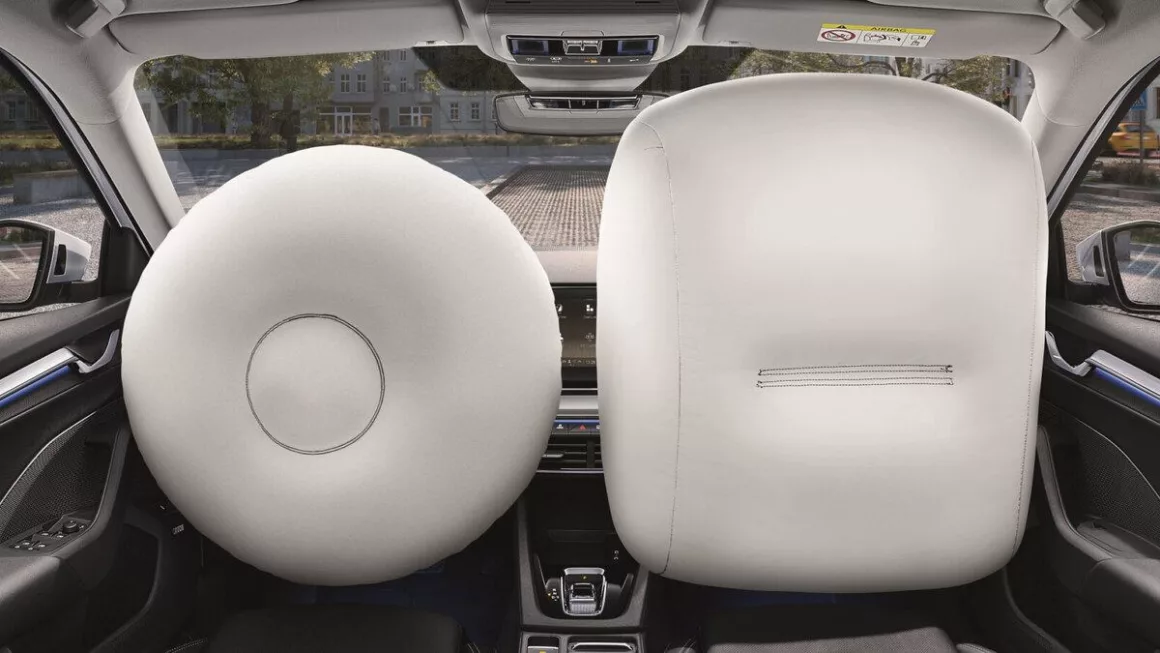The cushiony white balloon that has saved millions of lives since its invention, the Airbag is a simple yet effective solution to passenger safety and will go down in the history of automobiles as one of the most groundbreaking discoveries. Airbags are now a crucial part of every vehicle’s standard safety features and a big determining factor in making or breaking a car’s overall success in the market. With continuous technological developments, Airbags have come a long way, offering all-around protection for every passenger. Playing an integral role in ensuring overall passenger safety, airbags are rather fascinating as a piece of technology, often making people wonder how they work and what they’re made of. So if you are looking to learn all about car Airbags, here’s a brief yet informative article that will make you an Airbag pro.
What are Airbags in a Car?
Developed back in the 1950s, airbags are an integral part of the vehicle occupant restraint system, which is a collection of safety features designed to protect occupants during a crash and mitigate the severity of injury if caused.. In terms of basic design and functionality, airbags are essentially inflatable cushions installed in various parts of your vehicle. They are programmed to inflate and deflate within a fraction of a second in case of a crash to protect the vital organs of your body from traumatic impact. As technology developed, so has the fundamental airbag functionality, and they are now triggered via chemical reactions and work in synergy with several sensors and other occupant restraint systems, such as seat belts.
Components of an Airbag System
Modern-day supplemental restraint system (SRS) airbags have come a long way since the 1950s and are now built with several crucial components that work together in real time to help protect you during a crash. Some of the key components of an airbag are:
Airbag
Dubbed as the primary restraint system, the airbag is the cushion-like component, usually made of nylon that rapidly inflates and deflates to absorb the traumatic impact in case of a crash. The airbag is, therefore, one of the most crucial components of an airbag system. The airbag can be located in multiple places within a vehicle, however, the most common place for the airbag is in the steering wheel and dashboard, where it is installed to protect the head and chest areas of front occupants.
Airbag Inflator
Another important component of the airbag system, the airbag inflator, is the explosive instrument whose job is to keep the airbag inflated as long as the occupant protection system is activated. The Airbag inflator is composed of a chemical compound commonly referred to as sodium azide, which triggers the chemical reaction necessary for the inflation of the airbag.
Airbag Sensor
No modern-day airbag system is complete without airbag sensors. A device designed to measure the occupant’s weight and seating position, the airbag sensor collects data and sends signals to the airbag controller in the event of a potential collision. In general, the airbag sensor often forms part of the occupant protection system itself.
SRS Airbag Module
The supplement restraint system (SRS) airbag control module is a component that is usually located near the steering wheel in most cars. The job of the airbag module is to deploy the side and front airbags whenever a collision occurs. In some older vehicles, the airbag module can also be located under the dashboard. Since the job of the airbag module is to deploy the linked airbags, any fault in the module itself can mean a failure of the entire airbag system.
Clock Spring
A component that is usually made of steel, the clock spring is attached to the steering wheel housing and the steering wheel cover. In most vehicles, the clock spring is attached to the airbag control module. The clock spring comprises a spiral of multiple wires that connects the airbag module to the ignition switch, the car’s computer, and the steering wheel itself. When the ignition switch is locked, the clock spring ensures the airbag module is off.
Airbag Warning Light
Located on the instrument panel, the airbag warning light indicates that the airbags and the SRS have been successfully deployed. When the airbag warning light is on, it means the airbag inflation system is armed. When the airbag system is activated in a vehicle, it sends a signal that makes the airbag warning light glow. This usually lasts for a few seconds or more. Once the airbag warning light turns off, it indicates that the airbag system has deployed and is ready to function in case of any collision.
Wiring Harness
Also called the connector sub-harness, the wiring harness, like the nerves in the human body, is the main electrical connection of the airbag system. Its job is to transfer electric signals from the airbag module to the rest of the vehicle.
How does an Airbag Work?
Now that you have a fair idea of what makes up the airbag system in a car, you might be wondering how the airbag system and all its components work in real time to protect you and your loved ones during a crash. Here’s how the airbag system works:
The deployment of the airbag system starts from crash sensors, which are usually located in the front of the vehicle. In case the sensors detect a crash/collision or a sudden deceleration, a signal is sent to the airbag control unit. The airbag control unit receives the signal from the crash sensors as well as other sensors such as the wheel speed sensor, brake pressure sensors, seat belt sensors, etc, to analyse if the vehicle is involved in a crash/collision. Once the airbag control unit determines that there has been a crash/collision, it sends a signal to the airbag inflator. When the airbag inflator is triggered, it sets forth a chemical reaction that produces an explosion of nitrogen gas that rapidly fills up the airbag, causing it to inflate and absorb the traumatic impact, protecting the occupant’s vital organs. Once inflated, the airbag then deflates automatically.
Since crashes and collisions are unpredictable, airbag systems are designed to work within a fraction of a second. The entire process of triggering the airbag to its final deflation usually takes place within 55 milliseconds, which is also the time it usually takes to blink your eyes.
Importance of Airbags in a Car
As per the Ministry of Road Transport and Highway, India witnesses more than 4.5 Lakh road accidents every year with a more than 30% fatality rate. With such a huge number haunting every day, the importance of onboard safety equipment such as airbags could be the determining factor of life and death.
Airbags, as an occupant restraint system, make a huge impact in a potential accident or crash. Working effectively to protect the occupant’s vital organs such as the head, brain, chest, heart, lungs and spleen, airbags work effectively in real time to mitigate the injuries caused in an accident. The importance of airbags in a vehicle can truly be appreciated by those who have been involved in a crash or even by those who have seen their loved ones being saved by the deployment of airbags.
The Ministry of Road Transport and Highway has made dual front airbags a standard safety feature for all vehicles sold in India from January 1, 2022, and a compulsory inclusion of 6 airbags for all 8-seater vehicles sold in India with effect from October 2023.
Airbag Locations in a Car
The location of an airbag makes a large impact on how effective the airbag would be in protecting the occupant in case of a crash. Here are the various locations an airbag can be installed in a modern day vehicle:
Front Airbags
The front airbags are primarily installed to protect the occupant’s head and chest,

In case of a collision. The driver’s side front airbag is located in the steering wheel, while the passenger side front airbag is located in the dashboard. Modern-day vehicles also offer Knee Airbags that are located under the dashboard on each side of the driver as well as the passenger to offer knee protection during crashes.
Side Airbags
While head-on collisions are duly protected by the front airbags, side collisions are protected by the side airbags that are designed to protect the occupant’s head and chest in cases where the vehicle is struck by another vehicle or an object on the side. Since there is very little gap between the occupant and the vehicle’s sides, side airbags are designed to quickly engage and are installed in places such as the side of the front seat backrest, roof rail (curtain airbags), and door.
Tips for Airbag Maintenance
Now that you know all about the airbag system, it is important to know how to effectively maintain the airbag system to avoid failure during a crash. Here are a few things you should keep in mind to ensure effective airbag maintenance:
- Always wear seatbelts as the airbag system is designed to work effectively only when the seatbelts are on.
- Always pay attention to the airbag warning light on the instrument cluster. If you find your airbag warning light flashing or on continuously, get your vehicle’s airbag module checked and replaced.
- Avoid putting heavy objects on the dashboard and the car seats that can interfere with effective airbag deployment.
- Get your car’s electric system regularly checked and repaired in case of a fault.
- Replace your airbag module in case the airbags of your vehicle have ever been deployed.
FAQ
Q. What is an Airbag?
A: Airbags are inflatable cushions installed in various parts of your vehicle that are programmed to inflate and deflate within a fraction of a second in case of a crash to protect the vital organs of your body from traumatic impact.
Q. Where is the airbag in a car?
A: Front airbags are located in the driver’s side steering wheel and passenger side dashboard. Knee Airbags are located under the dashboard on each side, while side airbags are located in the door, the seats, and the roof rail.
Q. Is airbag compulsory in India?
A: Yes, the Ministry of Road Transport and Highway has made dual front airbags a standard safety feature for all vehicles sold in India from January 1, 2022, and a compulsory inclusion of 6 airbags for all 8-seater vehicles sold in India with effect from October 2023.





